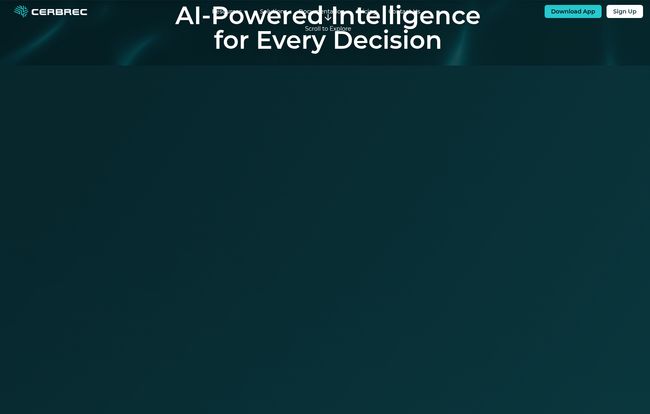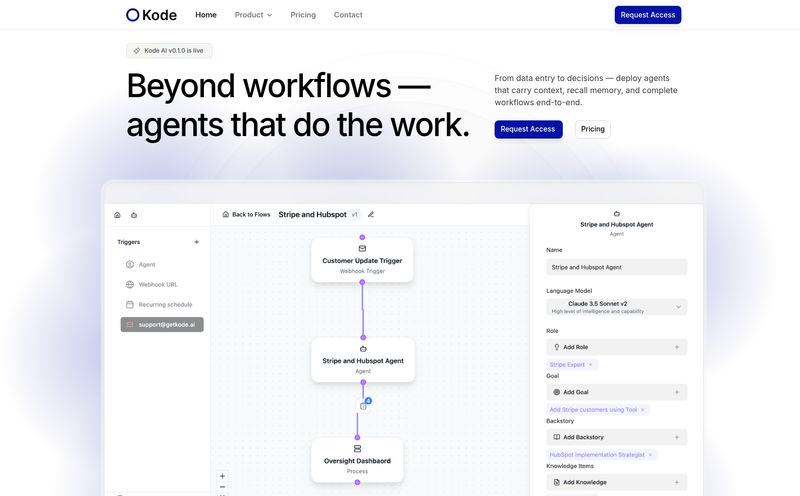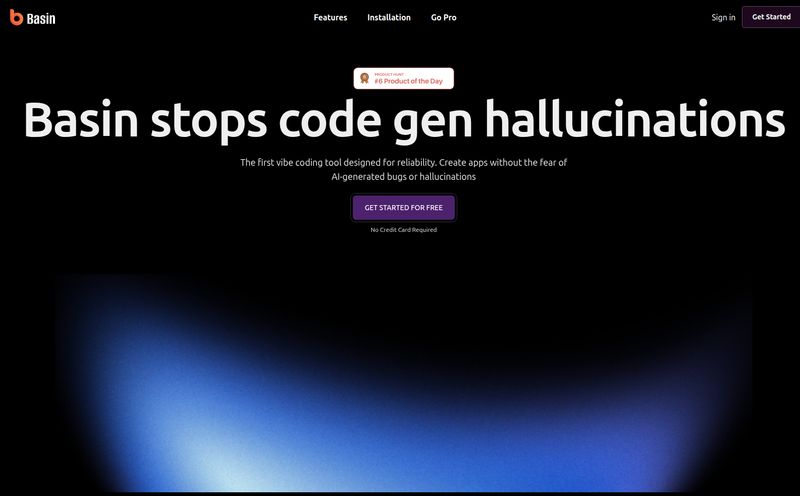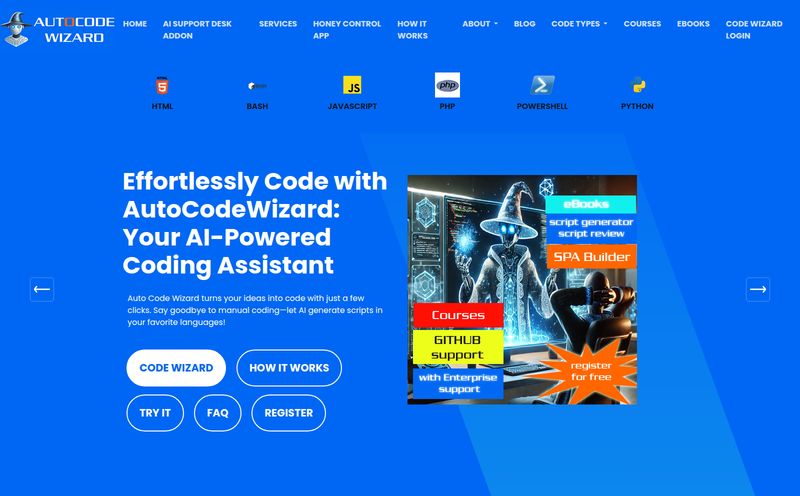I still have nightmares about my first attempts with deep learning. Seriously. Hours spent wrestling with dependencies in a Python environment, staring at a screen full of code that looked more like ancient runes than instructions, and getting error messages so cryptic they might as well have been written by the Zodiac Killer. I’m an SEO guy, a traffic guy. I understand logic and systems, but the barrier to entry for building a genuinely useful AI model felt like a sheer cliff face. And I know I'm not alone.
For years, the power of AI has been locked away, accessible only to those who speak fluent Python and have a Ph.D. in mathematics. But the tide is turning. We're seeing a wave of tools designed to democratize AI, to put the power in the hands of the people who actually have the problems to solve. And that brings me to the topic of today: Cerbrec Graphbook.
I stumbled across them recently, and their tagline,
AI-Powered Intelligence for Every Decision,
caught my eye. It's a bold claim. So, is it just another platform with lofty promises, or is it something more? Let's get into it.
So, What on Earth is Cerbrec Graphbook?
Let’s cut through the marketing jargon. At its heart, Cerbrec Graphbook is a visual deep learning framework. Think of it like this: if traditional AI development is like building a car engine from raw metal, smelting the steel and milling every single piston yourself, Graphbook is like having a full set of high-quality LEGO Technic pieces. You get to be the architect, the designer, snapping together pre-built, functional blocks to create something amazing, without needing to be a master metallurgist.
It’s a drag-and-drop system where you can visually map out the flow of your AI model. You pull in a data source, connect it to a data cleaning block, pipe that into a specific model architecture, and then send it to an output. It turns the abstract chaos of code into a logical, understandable flowchart. They call it a "data orchestrator," which is a pretty fitting description.
What really perked my ears up is that it's not just a visual tool. Graphbook also allows you to build using natural language queries. The idea that you could just… describe the solution you want and have it start building the framework for you? That feels like the future. It's also worth mentioning that Cerbrec is a venture of SRI International—yes, the same SRI that was instrumental in things like the computer mouse and Siri. That pedigree brings a certain weight and credibility that you don't get with every new startup on the block.
First Impressions and the Visual Interface
Based on what I’ve seen, the platform has a very clean, minimalist aesthetic. It's dark-themed, which my eyes appreciate after hours of staring at screens, and seems to prioritize clarity over clutter. The whole experience revolves around a canvas where you, the creator, literally draw out your model’s brain.

Visit Cerbrec Graphbook
You’d start by dragging a ‘node’ onto the canvas. Maybe it’s your customer data from a CSV file. Then you'd draw a line—a connector—to another node, say, one that removes duplicate entries. From there, another line to a pre-trained language model block. You can see the entire logic of your application laid out right in front of you. It’s intuitive. It’s tangible.
One of the biggest headaches in this field is debugging. An error on line 547 of a file you didn’t even write is enough to make you want to throw your laptop out the window. Graphbook's promise of AI error troubleshooting within this visual map could be a lifesaver. If a node turns red, you know exactly where the process broke down. No more hunting. That alone is a massive quality-of-life improvement.
Who is This Really For? The Coder vs. The Domain Expert
This is the classic debate with any low-code platform, isn't it? Is it for coders, or is it for everyone else? My take: it's for everyone else, and that's what makes it so exciting.
A marketing analyst who wants to build a sentiment analysis model for social media comments shouldn't have to learn TensorFlow. A biologist trying to classify cell images shouldn't need to become a software engineer. These are domain experts. They have the data and the vision, but not always the coding chops. Graphbook is built for them. It lowers the technical barrier so profoundly that it allows the people with the actual business problems to build their own solutions.
Now, will a seasoned data scientist at Google use this to build their next big thing? Probably not. Hardcore coders often want—and need—the granular, down-to-the-metal control that writing raw code provides. Using a visual builder can sometimes feel like trying to paint a masterpiece with a roller instead of a fine-tipped brush. It's a bit like Canva versus Adobe Photoshop. I can whip up a great-looking social media graphic in Canva in ten minutes. A professional designer will use Photoshop to create something with layers and effects I couldn't even dream of. Different tools for different jobs. And that’s perfectly okay.
A Few Features That Stand Out
A few things about the platform seem particularly smart. It's not just a simple drag-and-drop builder; there are layers to it.
First, the Collaboration and Model Sharing. AI development can be a really siloed process. A model might live on one data scientist's local machine, making it hard for a team to work on it together. Graphbook seems to treat models like shared documents. The idea of being able to share a complex model with a colleague as easily as a link is a big deal for team productivity.
Second, the focus on AI Safety. This isn't just a buzzword. In a world where we’re becoming increasingly aware of algorithmic bias and AI weirdness, building safety protocols directly into the framework from the ground up is the right move. It’s proactive, not reactive. It shows they're thinking about the real-world implications of the tools they're building.
What's the Price of Admission?
This is often the sticking point. A great tool is only great if you can afford it. And here, Cerbrec made a very interesting choice. Looking at their pricing, they have a Community plan that is completely free. As in, $0.
For that grand price of nothing, you get access to the core features: model development with visualization and templates, model sharing, and even 1GB of data storage to play with. This is a fantastic strategy. It removes any and all friction for someone like me to just sign up and start tinkering. It lets you prove the tool's value to yourself before you ever have to open your wallet.
There is a "Business" tab on their pricing page, which one can assume is the paid tier for professional teams. I'd speculate it includes things like increased data storage, advanced collaboration features, dedicated support, and perhaps some more powerful, proprietary model-building blocks. But for the individual, the student, or the small team just starting out, the free Community plan seems incredibly generous.
The Potential Downsides We Can't Ignore
No tool is perfect, and it's my job to be a bit of a skeptic. I do have some reservations, or at least, things to be aware of.
- The Learning Curve. I know, I know. It's a visual tool, how hard can it be? But every platform has its own quirks and logic. Learning the 'Graphbook way' of doing things will still take some time. It's not magic, it's just a different kind of interface to learn.
- Platform Lock-in. When you build your masterpiece inside a specific ecosystem, it can be hard to get it out. If you create a highly complex and business-critical model on Graphbook, migrating it to another platform or to raw code later on might be a significant challenge. It's a trade-off you make for convenience.
- The Glass Ceiling. As mentioned before, there will always be a point where the pre-built blocks aren't enough for some hyper-specific, cutting-edge use case. For 95% of problems, it's probably more than enough. But the top 5% of advanced users might eventually hit a wall.
My Final Verdict: Is Graphbook Worth Your Time?
So, the big question. Do I think Cerbrec Graphbook is the real deal?
Yes, I think it has a real shot. It’s entering the market at the perfect time, with a smart approach that targets the right audience: the millions of smart, capable people who have been left out of the AI revolution. It's not about replacing coders; it's about creating more builders.
The combination of a visual interface, natural language prompts, and a focus on safety and collaboration is a winning one. And with a free tier that lets you kick the tires with zero risk, there's really no reason not to give it a look if you've ever thought, "I wish I could build an AI for that." This might just be your chance.
Frequently Asked Questions (FAQ)
- What is Cerbrec Graphbook in simple terms?
- It's a platform that lets you build AI models using a visual drag-and-drop interface or by describing what you want in plain English, instead of writing complex code.
- Is Cerbrec Graphbook free to use?
- Yes, it has a free "Community" plan that includes core features for model development, sharing, and 1GB of data storage. There is also a "Business" plan, which is presumably a paid tier with more features for teams.
- Do I need to know how to code to use Graphbook?
- No. The entire point of the platform is to remove the coding barrier. It’s designed for domain experts, students, and anyone interested in AI, regardless of their programming background.
- Who is the ideal user for Graphbook?
- The ideal user is a non-coder who has a specific problem they want to solve with AI. This could be a marketer, a business analyst, a researcher, or a hobbyist who wants to experiment without a steep learning curve.
- How does this compare to TensorFlow or PyTorch?
- TensorFlow and PyTorch are powerful, code-based libraries for deep learning that offer maximum flexibility but require significant expertise. Graphbook is a higher-level platform that uses these kinds of technologies under the hood but presents them in a user-friendly, visual way. Think of it as an easy-to-use application built on top of a powerful engine.
- What does being a venture of SRI International mean?
- SRI International is a renowned nonprofit research institute with a long history of major technological innovations (like the computer mouse, Shakey the robot, and parts of what became the internet). Cerbrec being a venture from SRI suggests a strong foundation in serious research and development, lending it significant credibility.
The Future is Visual
The trend is clear. From web design with Webflow to app development with Bubble, the world is moving toward powerful visual development tools. It was only a matter of time before AI got the same treatment. The democratization of technology is always a good thing, and platforms like Cerbrec Graphbook are right at the forefront of that movement for artificial intelligence. It's an exciting time to be a creator.
Now, go check out that free plan and let me know what you build.



